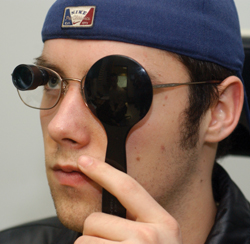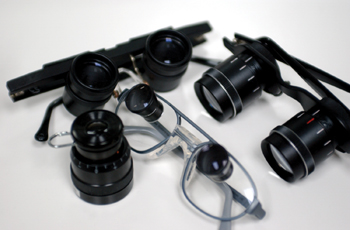
Patient Justin Simon reads an eye chart using his new bioptic telescope glasses. Photo by Dana Johnson
Program helps low-vision patients see more clearly

Devices such as these prescription telescopes and magnifiers are used to help patients in the Low Vision Clinic. Photo by Dana Johnson
Somewhere between the normal eyesight most people enjoy, and complete blindness, are those with low vision. Individuals with the ability to see, perhaps only within a narrow field of view directly ahead, or without the ability to clearly perceive the sharp detail of print even with the help of glasses or contact lenses.
Low vision is eyesight in the range of 20/70 to 20/8000 that cannot be corrected to within normally accepted limits with standard vision aids such as glasses or contact lenses. People with visual acuity of 20/200 or worse, with a visual field of 20 degrees or less, are classified as legally blind even if they possess sight.
Frequently, low-vision children and adults, even though they may possess enough vision to accomplish many day-to-day tasks with the assistance of low-vision aids, are left without these devices or appropriate intervention from trained professionals and instead accept the fate of being reliant on others for visual information.
The frustration for those trained to diagnose and treat people with low vision is a lack of awareness among these individuals or their parents, and many health care professionals for that matter, that help is available.
Unknown to most Tennesseans, is a unique multidisciplinary program at Vanderbilt University incorporating researchers from Peabody’s Department of Special Education, with physicians and clinical low- vision specialists in the Department of Ophthalmology and Visual Sciences, offering a broad continuum of education, research and patient care for children with low vision.
Additionally, through optometrists in the Department of Ophthalmology and Visual Sciences, specialized assistance exists for adults who were born with low vision, or have experienced vision deterioration later in life due to common diseases such as glaucoma or macular degeneration.
Under the direction of Anne L. Corn, Ed.D., professor of Special Education and professor of Ophthalmology and Visual Sciences, and through the auspices of a Tennessee Department of Education program called Project PAVE (Providing Access to the Visual Environment), the Department of Special Education at Vanderbilt offers comprehensive low-vision education and training for children and young adults up to age 21. These services are dedicated to prescribe and teach students to properly use their low-vision devices, and how to better integrate them into society.
“The children we help with PAVE are children who have visual impairment that cannot be corrected with standard glasses or contact lenses, and are going to have difficulties in school seeing standard print, the chalkboard, or just moving about,” said Corn.
Project PAVE is a collaborative outreach program funded through the Tennessee Department of Education and provided by the Department of Special Education at Vanderbilt University and the Tennessee School for the Blind. PAVE began in 1994 when Corn, PAVE’s founder and director, wrote a small grant for 10 low-vision children in Metro Nashville schools and the Tennessee School for the Blind to receive services.
“When you think about every thing you read in a day, you can’t even buy a bottle of aspirin in this country without having something in small print to read,” said Corn. “Our goal is to help these children to become visually independent, to have control over their environment, and to be able to read whatever they want or need.”
The unique state-funded program provides comprehensive clinical low-vision services for Tennessee’s children ages 3 through 21 in local education agencies across the state and the Tennessee School for the Blind.
Corn says children seen by PAVE have a variety of visual problems such as low visual acuity, restricted visual fields, light sensitivity, low contrast sensitivity, color perception difficulties and light sensitivities.
“What our project does is work with the children using a multi-disciplinary approach to provide low-vision services. We are unique in what we are offering from other programs around the country. Because we are a combined College of Education and Department of Ophthalmology and Visual Sciences project, we have a very effective model for being able to offer these services,” she said. In addition, there is an additional component of Project PAVE involving the University of Houston’s College of Optometry.
After children or adults have been clinically evaluated and prescribed an optical device they reach a critical point. Frequently these individuals require specialized instruction to learn to effectively use their optical devices to the fullest advantage in society.
Erika Andersen, one of four teachers and low-vision therapists in Vanderbilt’s Department of Special Education, works with children assisted by Project PAVE. Andersen travels throughout the state to provide visually impaired children comprehensive education and therapy to establish independence.
“Many of the children don’t look like they have a visual impairment, and they spend a lot of time trying to hide that fact. So disclosure, the first time a child uses an optical device in school or around peers, is a big hurdle,” said Andersen. “You have to build a lot of rapport for the child to feel comfortable to do that. A lot of the time that’s a major turning point for the child.”
Andersen says it’s this acceptance, both for the child and with the child’s peers, that is a big turning point in a visually impaired child’s life.
“While our project follows reading speeds and other academic indicators, we get feedback from families and teachers that a child’s social skills have been most impacted in a positive way,” she said. “The children are able to make friends, feel included, and not feel anxious in social settings.”
Through VUMC’s Department of Ophthalmology and Visual Sciences low vision patients of all ages receive comprehensive clinical assessments and prescription visual aids.
“Every one of the patients we see in clinic goes through an amazing transformation. The children in Project PAVE, and the adults we treat, are able to either rediscover or see things for the first time,” said Dr. Jeffrey Sonsino, optometrist in the Department of Ophthalmology and Visual Sciences, who oversees the Low Vision Clinic at VUMC.
“We would certainly like to get across the point that patients of any age are eligible for visual rehabilitation. In clinic we do a specialized assessment on each patient to determine what vision they do and don’t have. We then prescribe optical devices to help them get the most out of the eye they can.”
Sonsino says many of the adult patients he sees have lost some or all of their central vision. But with help there are other ways to allow these people to use their eyes and work around the disability.
Sonsino would like health care professionals and potential patients to know there are effective visual aides and visual rehabilitation services available for people of all ages. “If there is sight at all, then there is something we can do,” he said.
“While the youngsters can participate in Project PAVE, we have in place a program for adults of any age to receive training to use low-vision aids,” he said. “Insurers such as Medicare have finally begun to recognize the importance of this and we’re beginning to integrate occupational therapists to help train adults. There are millions of Americans with low vision in adulthood, so there is an acute need.”
One of Corn’s goals, as well as the goal of the Department of Ophthalmology and Visual Sciences, is to develop a program similar to PAVE that would secure funding for comprehensive training and assistance for Tennessee’s adults with low vision.
“Due to Americans living much longer we’re starting to see large numbers of adults with age-related diseases such as macular degeneration that rob them of sight. It’s very important that we begin to address this issue so these people can live independently for as long as possible,” she said.
For more information about Project PAVE, call 322-2249, or toll free 1-877-269-6294. For more information about the Department of Ophthalmology’s Adult Center for Sight Enhancement, call 936-1477.













